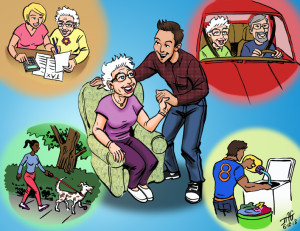Old neighborly ways for a new economic era
Like other support programs for the elderly and their caregivers sponsored by the Westchester Public-Private Partnership for Aging Services, this recent award-winning one began as a demonstration project on a small scale.
A 90-year-old married couple in the county was in need of help in the tasks of daily living. Both husband and wife suffered from dementia.

At the county Department of Senior Programs and Services ”“ the prime mover behind the 22-year-old Aging Services partnership of businesses, nonprofits, public agencies and consumers ”“ staff turned to a traditional source of help for a community”™s elders that did not require public funding: neighbors.
Neighbors volunteered to cook for the couple. They drove the wife to visit her husband during his hospitalization. Some helped despite unfriendly relations in the past with their elderly neighbors.
When the hospital”™s discharge plan required that the couple not spend nights alone, neighbors teamed up on a solution. For 10 nights they took turns staying with the couple until a young relative arrived from California to take over caregiving duties.
“We said, ”˜Let”™s bottle this; let”™s formalize this,”™” said Mae Carpenter, commissioner of the county department serving the elderly in Westchester, where one out of five residents is 60 or older.
The result is Care Circles of Westchester, a program of the Livable Communities Initiative, another award-winning effort that was launched four to five years ago by the county”™s public-private partnership for the aging. “Step forward and give back” is the motto and recruiting slogan for the volunteers of Care Circles.
That volunteer help enables elderly residents to stay in their homes and avoid costly institutional care. The Care Circles program also saves taxpayer money, Westchester County Executive Robert P. Astorino has noted. The average yearly cost for a nursing home in Westchester is $120,000, he said.
The Care Circles program recently won the National Association of Area Agencies on Aging”™s Innovations Award.
The association also conferred an achievement award on another initiative sponsored by the county”™s coalition for the aging, a seven-week think tank study coordinated last winter by the 9-year-old Westchester Alliance of Academic Institution for Aging-Related Studies and Workforce Development.
The report, “Driving for Solutions,” was the work of nine students from six colleges in New York, including Westchester”™s Mercy College, Pace University, Sarah Lawrence College and SUNY Purchase. The study focused on ways to improve transportation options for elderly residents in the county”™s rural northeast region and for home care workers that have found travel to those distant areas too expensive, leaving aging residents without the aid they need.
Those who work with and for her laud Carpenter as the visionary behind Livable Communities and the numerous innovative projects and collaborations that have made Westchester County”™s approach to aging issues a model for other states and municipalities. The Livable Communities caregiver coaching program has even been adopted by a village in Portugal, said Colette Phipps, research analyst at the county Department of Senior Programs and Services and executive director of the Livable Communities Initiative.
Yet Carpenter dismisses the visionary label bestowed on her for her brainstorms in the service of the county”™s growing aging population and their caregivers, 33,000 of whom tend to the daily needs of Westchester residents 60 or older, according to county officials. “It”™s not vision. It”™s common sense,” she said recently in her Mount Vernon office.
“I don”™t spend a day creating a publicly funded project because the money just isn”™t there.” Instead she devotes her efforts to private projects that typically rely on community and family practices that have eroded in Westchester and beyond.
Many of the services performed by Care Circles and Livable Communities volunteers ”“ escorting the elderly on trips and shopping for them, for example ”“ used to be done by grandchildren or other family members, she said. But many of Westchester County”™s youths have relocated to other areas of the country “because of the high cost of living here,” Carpenter said. “So that leaves a lot of older people without an intergenerational support system.” Some volunteer programs started here are efforts to fill that void.
“It”™s really going back to helping people out, like it used to be” in America”™s neighborhoods, she said.
The Livable Communities program is attempting to recreate those neighborly support systems with “villages” that monitor and help meet the various needs of the elderly among them. The villages include churches and interfaith groups, libraries, nonprofit service and health care agencies, public authorities and agencies, tenant groups, senior living facilities, community centers and senior citizen clubs, pharmacies and other businesses and the 1,200-member Business Council of Westchester. In the last two years, 185 such villages have been created in the county that collectively number more than 89,000 members.
Economic insecurity ”“ “falling through the trap door,” as Carpenter describes it ”“ is another growing problem among Westchester”™s elderly. Phipps said 73 percent of respondents to an economic security index survey “say they”™re underwater” financially.
“A lot of elderly are in that situation where they”™re finding they”™re helping their adult children and their grandchildren” with their financial needs, thereby depleting the savings they might need as their health deteriorates with advancing age.
In Westchester, “A lot of elderly can”™t handle their property taxes,”™ said Carpenter. “Until they do something about these property taxes, people will not be able to meet their basic physiological needs.”
Carpenter and her colleagues in the public and private sectors have begun addressing solutions to that.
“These are extremely challenging times,” she said.